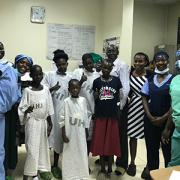Assessing the global burden of rheumatic heart disease

A research team that included Children’s National Heart Institute experts Andrea Beaton, M.D., and Craig Sable, M.D., examined data on fatal and nonfatal Rheumatic Heart Disease for a 25 year period from 1990 through 2015 to determine the current global burden of RHD.
Rheumatic Heart Disease (RHD) is the most commonly acquired heart disease in young people under the age of 25. It’s caused by untreated streptococcal throat infections that progress into acute rheumatic fever and eventually weaken the valves of the heart. Fortunately, the devastating condition, which was endemic in the United States before 1950, is now relatively rare in the developed world due to social and economic development and the introduction of penicillin. But, as shown in a recent study published in the New England Journal of Medicine, in the developing world, RHD remains nearly as common as HIV.
As part of the 2015 Global Burden of Disease Study, a research team that included Children’s National Heart Institute experts Andrea Beaton, M.D., and Craig Sable, M.D., examined data on fatal and nonfatal RHD for a 25 year period from 1990 through 2015 to determine the current global burden of RHD. The group employed epidemiologic modeling techniques to estimate the global, regional and national prevalence of RHD, as well as death rates and disability-adjusted life years attributable to the disease.
“This study provides more detail than ever before about the global impact of RHD,” explains Dr. Sable. “It utilizes global burden of disease tools that are updated on an annual basis. These tools are considered highly reputable and allow for ongoing tracking and comparison to other diseases.”
The researchers found that overall, death rates from RHD have declined: there were 347,500 deaths from RHD in 1990 and 319,400 deaths in 2015, a decrease of 8 percent. From 1990 to 2015, the global age-standardized death rate from RHD also decreased from 9.2 to 4.8 per 100,000 — a change of 48 percent.
However, a closer look at the data shows that progress on RHD remains uneven. Although the health-related burden of RHD has declined in most countries over the 25-year period, the condition persists in some of the poorest regions in the world, with the highest estimated death rates in Central African Republic, Federated States of Micronesia, Fiji, India, Kiribati, Lesotho, Marshall Islands, Pakistan, Papua New Guinea, the Solomon Islands and Vanuatu. In several regions, mortality from RHD and the number of individuals living with RHD did not appreciably decline between 1990 and 2015. The researchers estimate that 10 out of every 1,000 people living in South Asia and central sub-Saharan Africa and 15 out of 1,000 people in Oceania were living with RHD in 2015.
“These data are critically important for increasing awareness and funding to reduce the global burden of rheumatic heart disease,” says Dr. Sable. “Dr. Beaton and I are proud to be part of a small team of global investigators leading this effort.”
Children’s National Health System was recently awarded a grant from the American Heart Association to launch a Rheumatic Heart Disease Center, with the goal of developing innovative strategies and economic incentives to improve the prevention and diagnosis of RHD in high-risk, financially disadvantaged countries and low-income communities across the United States. The program will use Children’s robust telemedicine infrastructure to connect co-collaborators around the world, as well as train the next generation of globally minded cardiovascular researchers.











